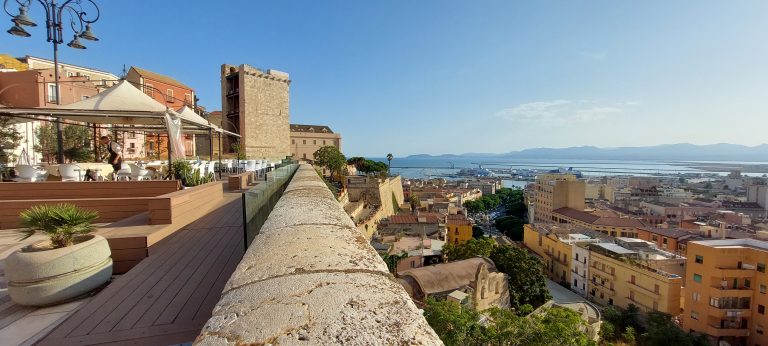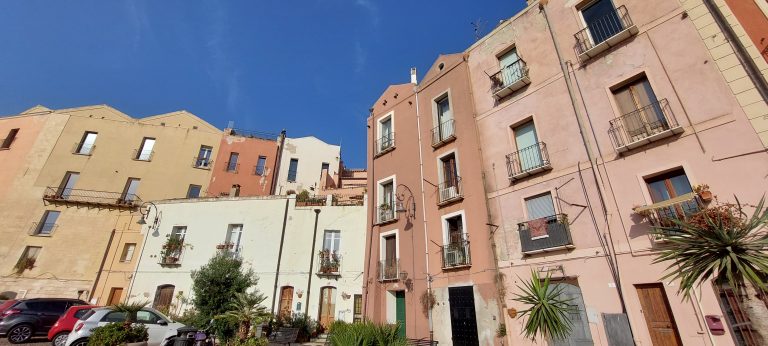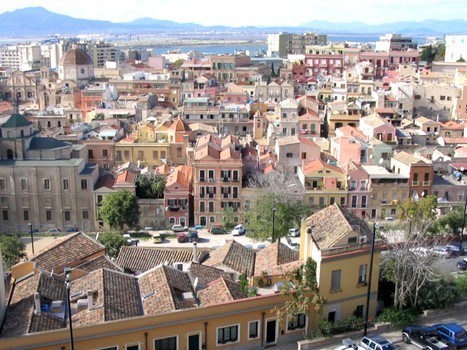Urban trekking is a form of sustainable tourism that involves visiting a city through the lesser known but more experienced circuits of the local inhabitants. A freer and richer way of tourism that teaches people to experience the city in an active and healthy way. Suitable for everyone, urban trekking does not require any particular physical ability but aims, step by step, to help people discover the many hidden treasures in the city.
Walking in Cagliari: our route in the city centre
Visiting Cagliari through an urban trekking route is the best way to fully experience its many facets. The city, the capital of Sardinia, is full of history, art and culture. But it is its lively and bright atmosphere that makes it special and pleasant to discover. Our route into the centre begins in via Sassari, which is convenient for those arriving in the city, and is a short walk from the port and the station, both in via Roma. Walking along Via Sassari and leaving Piazza del Carmine to the left, we set off towards Corso Vittorio Emanuele, the city’s salon, lined with elegant palazzi and hidden narrow streets. One of these is via Tigellio, named after a Latin poet who was the owner of a Roman stately home from the imperial era whose ruins are still visible today.
Taking the steps that lead from Via Sassari to Via Ospedale, one turns into Via Porto Scalas and ascends Viale Fra Ignazio. Along this road, which is busy with many students attending the Faculties of Economics, Law and Political Science at the University of Cagliari, you will come across, in order of distance: the city’s botanical garden, home to more than 2,000 botanical species of all origins, the Sanctuary of Sant’Ignazio da Làconi, and the ruins of the largest Roman amphitheatre in Sardinia, built between the 1st and 2nd centuries AD.

Leaving the amphitheatre behind, we will walk up viale Buoncammino and admire one of the most impressive views of the city. We will take a break on the verandas of the avenue and then turn back towards Castello: the fortified medieval quarter. The quarter is accessed through Porta Cristina, named after the consort of King Carlo Felice of Savoy, Maria Cristina of Bourbon. Immediately after crossing the threshold we are in Piazza Arsenale and can admire the ancient Royal Arsenal on the left, the current site of the Cittadella dei Musei and the National Archaeological Museum. On the right, passing through another door, we arrive in the historic heart of the district. On the left is the Tower of San Pancrazio, built at the behest of the Pisans in the early 14th century together with its twin, the Tower of the Elephant. Walking down Via Cannelles, we arrive in Piazza Palazzo, where we meet the Palazzo Regio, also known as the Viceregio, and the city’s Cathedral.
Continuing along Via del Fossario, you will descend the steps leading to the Bastion of Saint Remy, on the Terrazza Umberto I, built in the early 20th century on the ancient Spanish bastions of the Zecca and the Sperone to connect the upper quarter of Castello to the lower ones of Villanova and the Marina.
After admiring the view, you can decide whether to leave the quarter and walk down the monumental staircase to Piazza Costituzione, or continue the route through the picturesque alleyways in Castello. For the latter choice, head down Via San Giuseppe, until you reach the foot of the Elephant Tower. From here we continue to Via Corte d’appello, where we find the building that now houses the Faculty of Architecture, a former college founded by the Jesuits in the 17th century. Later, these premises housed the Royal Printing House, the Monte di Pietà, the Royal Archives, the Royal Hearing Office and then became the Court of Appeal until 1940, hence the name of the street.

Continuing along via Santa Croce, we pass the bastion of the same name and the Basilica, the former synagogue of the Jewish quarter, and head into via Cammino Nuovo, via San Giorgio, until we reach via Ospedale and via Sant’Efisio: along which is the small church of Sant’Efisio, the parish church of Sant’Anna and, a little further on, the church of Santa Restituta. Once in Via Azuni, one heads to Piazza Yenne, the heart of ‘modern’ Cagliari. The square, formerly Piazza S. Carlo, dates back to 1822, when the viceroy, Marquis of Yenne, placed the milestone indicating the starting point of the new Carlo Felice road that would join Cagliari to Porto Torres. The bronze statue of Carlo Felice dominates the centre of the square. After walking along the Largo of the same name, we arrive back at our starting point, Via Roma: the elegant promenade along the porticoes with its ancient palaces, the Town Hall and the waterfront on the harbour welcome the arriving ships and bid farewell to those who leave, leaving in this city the promise of a return.
The four historic quarters of the city
During our trek we will see the four historic quarters of Cagliari:
- Castello
- Stampace
- Marina
- Villanova
The district of Castello gives its name to the city, which in Sardinian is called Casteddu. During a tour through the streets of this quarter you will immediately notice the Pisan influence that gave the city its present-day shape in 1200. In Castello, you can admire architectural works such as the tower of San Pancrazio and the tower of the Elephant, the Cathedral of Santa Maria and the Bastione Saint Remy from which, if you are lucky, you can experience one of the most evocative and fascinating sunsets in the city. Also in the neighbourhood is the Citadel of Museums, a favourite destination for any culture lover, containing the national archaeological museum, the regional ethnographic museum and the national picture gallery.
The Stampace district is mainly known for the festival of Sant’Efisio, one of the most important religious processions in Sardinia. It takes place every year on 1 May and consists of a four-day-long procession during which the saint is transported from Cagliari to Nora and then brought back to Cagliari for the dissolution of the vow. During a visit to this neighbourhood, a visit to the church and prison of Sant’Efisio is a must, but as you continue walking you will be enchanted by the other monumental churches such as San Michele and Sant’Anna, the crypt of Santa Restituta and the Roman amphitheatre near the botanical garden, which is also a beautiful attraction where you can spend a relaxing afternoon alone or in company.
The Marina district is bordered to the north by the castle walls and to the south by Via Roma, which overlooks Cagliari harbour. During a walk through the streets of this marvellous quarter, you will be able to admire various historical and cultural testimonies: the church of Sant’Eulalia, where excavations have brought to light architectural testimonies from the Roman era, and the church of Sant’Agostino, one of the few examples of Sardinian Renaissance architecture. You will also see beautiful civil buildings such as the former hospital, historic hotels where the famous Honoré de Balzac and David Herbert Lawrence, among others, stayed, and spectacular streets such as the famous Via Manno, Viale Regina Margherita, Via Roma and Largo Carlo Felice.
Finally, the quarter of Villanova, the most recent of the four, will surprise you with its characteristic low simple houses and small shops. During a walk through its streets you will admire the church of San Saturnino, the oldest church in Cagliari, the church of San Giacomo and the church of Santo Domenico. Villanova is also the quarter where the confraternity in charge of the Holy Week celebrations is based. There are also beautiful Art Nouveau buildings such as the beautiful Palazzo Valdes and noteworthy redevelopments such as the ex-slaughterhouse of Cagliari (exMà), now an important cultural centre that promotes contemporary arts through exhibitions and educational tours.
Parks in the city, Cagliari’s green areas
Cagliari also has many green areas where you can relax, go jogging or simply enjoy a picnic in the open air. The park of Monte Urpinu is the city’s historical park. Frequented by many young people, families and sportsmen, it is the ideal place to admire mallard ducks, beautiful peacocks and turtles splashing around in the various ponds inside. The flora in the park is also diverse, ranging from a pine forest that provides shade for the hottest hours to various typical Mediterranean plants such as myrtle, rosemary and juniper. Inside there is also a viewpoint called Belvedere from which it is possible to admire the city of Cagliari and the Castello from above.
The Music Park, opened in 2011, is located next to the opera house. It features modern architecture with a small artificial river and fountains that spray water to the rhythm of music. It enjoys an excellent location in the city centre and is therefore very popular all year round. Often events and musical performances are organised here that are highly appreciated by the locals.
Cagliari’s public gardens, on the other hand, are much older and in fact constitute a beautiful testimony of a 19th century park. During a walk you can admire several fountains and sculptural elements such as the statue of the great Herculaneum. Here, too, the vegetation is wonderful and includes specimens of ficus, palm trees and multicoloured flower beds.
The Molentargius park, directly behind the Poetto bathing area, is a green area created with the aim of protecting and enhancing the area’s typical fauna: the Grey Heron and the famous pink flamingos. Inside the park there are several cycling, walking and horse-riding routes. Several group birdwatching tours are also available, an experience that will allow you to enjoy the spectacle of birds in the wild.
Finally, the Monte Claro park, also in the city centre. It is a favourite destination for families and sports enthusiasts in the city as it offers jogging trails and play facilities for children. Various cultural and leisure events are also organised in this park in the summer and are very popular and well-attended. Inside the park, at the top of the hill stands the famous Villa Clara, today home to the Emilio Lussu library. The park also has two dog areas, one for small dogs and one for larger dogs.

The local recipes to taste on a weekend in the city
To discover the true identity of a place, tasting its tastes and smells is always a good habit. During a weekend in Cagliari, these are the must-try dishes you should taste:
- Sa Burrida a sa casteddaia. This is a seafood starter based on stewed dogfish (a small shark found in the Mediterranean Sea) seasoned with vinegar, walnuts, fish livers, oil, garlic and parsley.
- Spaghittus cun arizzonis. These are the famous spaghetti with sea urchins, found throughout Sardinia but typical of the Cagliari area. The sea urchin is a real treat for the palate that does not need any flavouring to enhance its taste. Perfect balance between sweet and salty, once you try it, you won’t be able to do without it!
- Known in Sardinia as Pisci a collettu, it is one of the simple dishes of the peasant tradition. The name means fish with a collar, probably indicating that broad beans were the only ‘fish’ the poor could afford. It consists of dried broad beans cooked with garlic, mint, oil and salt. This dish, traditionally served hot, is always striking for its simplicity and goodness.
- Aligusta a sa casteddaia. Opposite to its Alghero Catalan rival, lobster a sa casteddaia is characterised by a simpler preparation of water, bay leaves, onion and parsley. Strictly to be eaten with the hands!
The best places to sleep for the weekend
Sleeping in the central districts is a good choice for those who like to get lost in the narrow streets of the centre and enjoy the nightlife among excellent clubs and restaurants. You can choose from charming B&Bs, elegant boutique hotels or comfortable apartments. The good news is that these places are open all year round
 it
it de
de nl
nl en
en fr
fr

